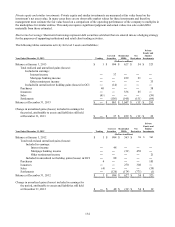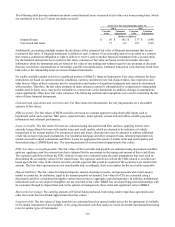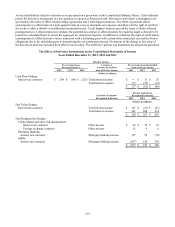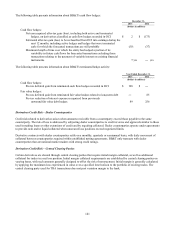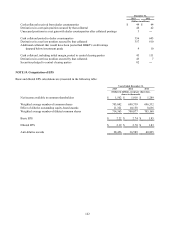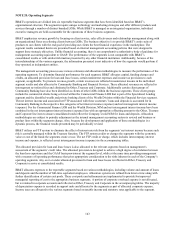BB&T 2013 Annual Report Download - page 133
Download and view the complete annual report
Please find page 133 of the 2013 BB&T annual report below. You can navigate through the pages in the report by either clicking on the pages listed below, or by using the keyword search tool below to find specific information within the annual report.133
The following discussion focuses on the valuation techniques and significant inputs for Level 2 and Level 3 assets and
liabilities.
A third-party pricing service is generally utilized in determining the fair value of the securities portfolio. Fair value
measurements are derived from market-based pricing matrices that were developed using observable inputs that include
benchmark yields, benchmark securities, reported trades, offers, bids, issuer spreads and broker quotes. As described by
security type below, additional inputs may be used, or some inputs may not be applicable. In the event that market observable
data was not available, which would generally occur due to the lack of an active market for a given security, the valuation of
the security would be subjective and may involve substantial judgment by management.
Trading securities: Trading securities are composed of various types of debt and equity securities, but the majority consists
of debt securities issued by the U.S. Treasury, GSEs, or states and political subdivisions. The valuation techniques used for
these investments are more fully discussed below.
U.S. Treasury securities: Treasury securities are valued using quoted prices in active over the counter markets.
GSE securities and MBS issued by GSE: GSE pass-through securities are valued using market-based pricing matrices that are
based on observable inputs including benchmark TBA security pricing and yield curves that were estimated based on U.S.
Treasury yields and certain floating rate indices. The pricing matrices for these securities may also give consideration to pool-
specific data supplied directly by the GSE. GSE CMOs are valued using market-based pricing matrices that are based on
observable inputs including offers, bids, reported trades, dealer quotes and market research reports, the characteristics of a
specific tranche, market convention prepayment speeds and benchmark yield curves as described above.
States and political subdivisions: These securities are valued using market-based pricing matrices that are based on
observable inputs including MSRB reported trades, issuer spreads, material event notices and benchmark yield curves.
Non-agency MBS: Pricing matrices for these securities are based on observable inputs including offers, bids, reported trades,
dealer quotes and market research reports, the characteristics of a specific tranche, market convention prepayment speeds and
benchmark yield curves as described above.
Other securities: These securities consist primarily of mutual funds and corporate bonds. These securities are valued based
on a review of quoted market prices for assets as well as through the various other inputs discussed previously.
Covered securities: Covered securities are covered by FDIC loss sharing agreements and consist of re-remic non-agency
MBS, municipal securities and non-agency MBS. Covered state and political subdivision securities and certain non-agency
MBS are valued in a manner similar to the approach described above for those asset classes. The re-remic non-agency MBS,
which are categorized as Level 3, were valued based on broker dealer quotes that reflected certain unobservable market
inputs. Sensitivity to changes in the fair value of covered securities is significantly offset by changes in BB&T’s
indemnification asset from the FDIC.
LHFS: Certain mortgage loans are originated to be sold to investors, which are carried at fair value. The fair value is
primarily based on quoted market prices for securities backed by similar types of loans. The changes in fair value of these
assets are largely driven by changes in interest rates subsequent to loan funding and changes in the fair value of servicing
associated with the mortgage LHFS.
Residential MSRs: The fair value of residential MSRs is estimated using an OAS valuation model to project MSR cash flows
over multiple interest rate scenarios, which are then discounted at risk-adjusted rates. The OAS model considers portfolio
characteristics, contractually specified servicing fees, prepayment assumptions, delinquency rates, late charges, other
ancillary revenue, costs to service and other economic factors. Fair value estimates and assumptions are compared to industry
surveys, recent market activity, actual portfolio experience and, when available, other observable market data.
Derivative assets and liabilities: The fair values of derivatives are determined based on quoted market prices and internal
pricing models that are primarily sensitive to market observable data. The fair values of interest rate lock commitments,
which are related to mortgage loan commitments and are categorized as Level 3, are based on quoted market prices adjusted
for commitments that are not expected to fund and include the value attributable to the net servicing fees.













